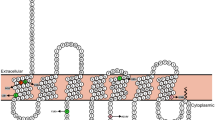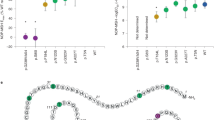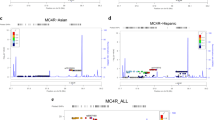Abstract
OBJECTIVE: Following several reports of linkage of obesity related phenotypes to human chromosome 20q we sought to determine whether variations of the melanocortin 3 receptor (MC3R) gene are associated with obesity.
DESIGN: We screened the MC3R gene coding region and approximately 2 kb of 5′ and 3′ flanking sequences for DNA variants in unrelated extremely obese women and average weight controls using polymerase chain reaction (PCR) single strand conformation polymorphism (SSCP) analysis and DNA sequencing.
SUBJECTS: 124 unrelated extremely obese women (body mass index, (BMI)≥40 kg/m2) and 85 average weight controls (BMI<27 kg/m2).
MEASUREMENTS: Radiation hybrid (RH) mapping was performed to localize the MC3R gene. 5′ and 3′ flanking sequences of MC3R gene were cloned. PCR-SSCP and DNA sequencing were used to detect mutations in the MC3R gene coding region and flanking sequences.
RESULTS: RH mapping localized the MC3R gene to 20q13, between markers D20S100 and D20S149. 1083 bp 5′ and 653 bp 3′ flanking region of the MC3R gene were cloned. A missense mutation (+241, codon 81 ATT/GTT, Ile→Val) was found in the MC3R coding region. Four more variants were detected in the 5′ flanking sequence: −201(C→G), −239 (A→G), −762(A→T) and −769(T→C). Compared with controls, no significant allele frequency differences were found. Racial differences were found for the +241, −201, −239 and −762 polymorphisms.
CONCLUSIONS: Several sequence variants were found in the MC3R gene coding region and in 5′ flanking sequences. However, none of the variants were associated with obesity phenotypes. The linkage of extreme human obesity on 20q13 is likely caused by genes other than MC3R.
This is a preview of subscription content, access via your institution
Access options
Subscribe to this journal
Receive 12 print issues and online access
$259.00 per year
only $21.58 per issue
Buy this article
- Purchase on Springer Link
- Instant access to full article PDF
Prices may be subject to local taxes which are calculated during checkout

Similar content being viewed by others
References
Perusse L, Chagnon Y, Weisnagell J, Bouchard C . The human obesity gene map: the 1998 update Obesity Res 1999 7: 111–129.
Lembertas AV, Perusse L, Chagnon YC, Fisler JS, Warden CH, Purcell-Huynh DA, Dionne FT, Gagnon J, Nadeau A, Lusis AJ, Bouchard C . Identification of an obesity quantitative trait locus on mouse chromosome 2 and evidence of linkage to body fat and insulin on the human homologous region 20q J Clin Invest 1997 100: 1240–1247.
Mehrabian, M, Wen, P-Z, Fisler, J, Davis, RC, Lusis, AJ . Genetic loci controlling body fat, lipoprotein metabolism, and insulin levels in a multifactorial mouse model J Clin Invest 1998 101: 2485–2496.
Lee JH, Reed DR, Li W-D, Xu W, Joo E-J, Kilker RL, Nathakumar E, North M, Sakul H, Bell C, Price RA . Genone scan for human obesity and linkage to markers in 20q13 Am J Hum Genet 1999 64: 196–209.
Pomp D . Genetic dissection of obesity in polygonic animal models Behav Genet 1997 27: 285–306.
Taylor BA, Phillips SJ . Obesity QTLs on mouse chromosomes 2 and 17 Genomics 1997 43: 249–257.
Gantz I, Tashiro T, Barcroft C, Konda Y, Shimoto Y, Miwa H, Glover T, Munzert G, Yamada T . Localization of the genes encoding the melancortin-2 (adrenocorticotropic hormone) and melanocortin-3 receptors to chromosomes 18p11.2 and 20q13.2-q13.3 by fluorescence in situ hybridization Genomics 1993 18: 166–167.
Gantz I, Shimoto Y, Konda Y, Miwa H, Dickinson CJ, Yamada T . Molecular cloning, expression, and characterization of a fifth melanocortin receptor Biochem Biophys Res Commu 1994 200: 1214–1220.
Mountjoy KG, Robbins LS, Mortrud MT, Cone RD . The cloning of a family of genes that encode the melanocortin receptors Science 1992 257: 1248–1251.
Gantz I, Konda Y, Tashiro T, Shimoto Y, Miwa H, Munzert G, Watson SJ, DelValle J, Yamada T . Molecular cloning of a novel melanocortin receptor J Biol Chem 1993 268: 8246–8250.
Gantz I, Miwa H, Konda Y, Shimoto Y, Tashiro T, Watson SJ, DelValle J, Yamada T . Molecular cloning, expression, and gene localization of a fourth melanocortin receptor J Biol Chem 1993 268: 15174–15179.
Chhajlani V, Muceniece R, Wikberg JE . Molecular cloning of a novel human melanocortin receptor [published erratum appears in Biochem Biophys Res Comm 1996 Jan 17; 218: 638] Biochem Biophys Res Commun 1993 195: 866–873.
Chowdhary BP, Gustavsson I, Wikberg JE, Chhajlani V . Localization of the human melanocortin-5 receptor gene (MC5R) to chromosome band 18p11.2 by fluorescence in situ hybridization Cytogenet Cell Genet 1995 68: 79–81.
Chajlani V . Distribution of cDNA for melanocortin receptor subtypes in human tissues Biochem Mol Biol Int 1996 38: 73–80.
Marsh DJ, Hollopeter G, Huszar D, Laufer R, Yagaloff KA, Fisher SL, Burn P, Palmiter RD . Response of melanocortin-4 receptor-deficient mice to anorectic and orexigenic peptides Nature Genet 1999 21: 119–122.
Yeo GSH, Farroqi IS, Aminian S, Halsall DJ, Stanhope RG, O'Rahilly S . A frameshift mutation in MC4R associated with dominantly inherited human obesity Nature Genet 1998 20: 111–112.
Vaisse C, Clement K, Guy-Grand B, Froguel P . A frameshift mutation in human MC4R is associated with a dominant form of obesity Nature Genet 1998; 20: 113–114.
Yang YK, Tompson DA, Dickinson CJ, Wilken J, Barsh GS, Kent SB, Gantz I . Characterization of Agouti-related protein binding to melanocortin receptors Mol Endocrinol 1999 13: 148–155.
Price RA, Reed DR, Lee JH . Obesity related phenotypes in families selected for extreme obesity and leanness Int J Obes Relat Metab Disord 1998 22: 406–413.
Lahiri D, Nurnberger J . A rapid non-enzymatic method for the precipitation of HMW DNA from blood for RFLP studies Nucleic Acids Res 1991 19: 5444.
Valverde P, Healy E, Sikkink S, Haldane F, Thody AJ, Carothers A, Jackson IJ, Rees JL . The Asp84Glu variant of the melanocortin 1 receptor (MC1R) is associated with melanoma Hum Mol Genet 1996 5: 1663–1666.
Frandberg PA, Doufexis M, Kapas S, Chhajllani V . Human pigmentation phenotype: a point mutation generates nonfunctional MSH receptor Biochem Biophys Res Comm 1998 245: 490–492.
Tsigos C, Arai K, Hung W, Chrousos GP . Hereditary isolated glucocorticoid deficiency is associated with abnormalities of the adrenocorticotropin receptor gene J Clin Invest 1993 92: 2458–2461.
Tsigos C, Arai K, Latronico AC, DiGeorge AM, Rapaport R, Chrousos GP . A novel mutation of the adrenocorticotropin receptor (ACTH-R) gene in a family with the syndrome of isolated glucocorticoid deficiency, but no ACTH-R abnormalities in two families with the triple A syndrome J Clin Endocrinol Metab 1995 80: 2186–2189.
Clark AJ, McLoughlin L, Grossman, A . Familial glucocorticoid deficiency associated with point mutation in the adrenocorticotropin receptor Lancet 1993 341: 461–462.
Weber A, Toppari J, Harvey RD, Klann RC, Shaw NJ, Ricker AT, Nanto-Salonen K, Bevan JS, Clark AJ . Adrenocorticotropin receptor gene mutations in familial glucocorticoid deficiency: relationships with clinical features in four families J Clin Endocrinol Metab 1995 80: 65–71.
Naville D, Barjhoux L, Jaillard C, Faury D, Despert F, Esteva, Durand P, Saez JM, Begeot M . Demonstration by transfection studies that mutations in the adrenocorticotropin receptor gene are one cause of the hereditary syndrome of glucocorticoid deficiency J Clin Endocrinol Metab 1996 81: 1442–1448.
Chagnon YC, Chen WJ, Perusse L, Chagnon M, Nadeau A, Wilkison WO, Bouchard C . Linkage and association studies between the melanocortin receptors 4 and 5 genes and obesity-related phenotypes in the Quebec Family Study Mol Med 1997 3: 663–673.
Quandt K, Frech K, Karas H, Wingender E, Werner T . MatInd and MatInspector–New fast and versatile tools for detection of consensus matches in nucleotide sequence data Nucleic Acids Res 1995 23: 4878–4884.
Ayala FJ . The myth of eve: molecular biology and human origina Science 1995 270: 1930–1936.
Ewens W, Speilman RS . The transmission/disequilibrium test: history, subdivision, and admixture Am J Hum Genet 1995 57: 455–464.
Acknowledgements
This work was supported by the National Institutes of Health (NIH; R01DK44073 and R01DK48095), and Axys Pharmaceuticals and Glaxo Wellcome (RAP, PI). Collection of mental health controls was supported by P01MH43880 (Raquel E. Gur, PI). We acknowledge the cooperation of our subjects. We thank Guang Ming Yuan, Robin L. Kilker, Nicholas Guido, Andrew C. Krakowski, Balasahib Shinde, Sami Weisberg, Christa A. Mayr, Elizabeth Joe, Kruti Quazi, Karynn Henry, Paula Kown, Timothy Gasperoni, Richard Joseph, Duc Bach and sequencing technical assistance from Axys. Drs. Joseph H. Lee and Danielle R. Reed commented on earlier drafts.
Author information
Authors and Affiliations
Corresponding author
Rights and permissions
About this article
Cite this article
Li, WD., Joo, EJ., Furlong, E. et al. Melanocortin 3 receptor (MC3R) gene variants in extremely obese women. Int J Obes 24, 206–210 (2000). https://doi.org/10.1038/sj.ijo.0801114
Received:
Revised:
Accepted:
Published:
Issue Date:
DOI: https://doi.org/10.1038/sj.ijo.0801114
Keywords
This article is cited by
-
Alpha-melanocyte stimulating hormone (α-MSH): biology, clinical relevance and implication in melanoma
Journal of Translational Medicine (2023)
-
A mouse model for a partially inactive obesity-associated human MC3R variant
Nature Communications (2016)
-
Participation of the central melanocortin system in metabolic regulation and energy homeostasis
Cellular and Molecular Life Sciences (2014)
-
Identification of Three Novel Genetic Variants in the Melanocortin‐3 Receptor of Obese Children
Obesity (2011)
-
Common melanocortin-3 receptor variants are not associated with obesity, although rs3746619 does influence weight in obese individuals
Endocrine (2010)



